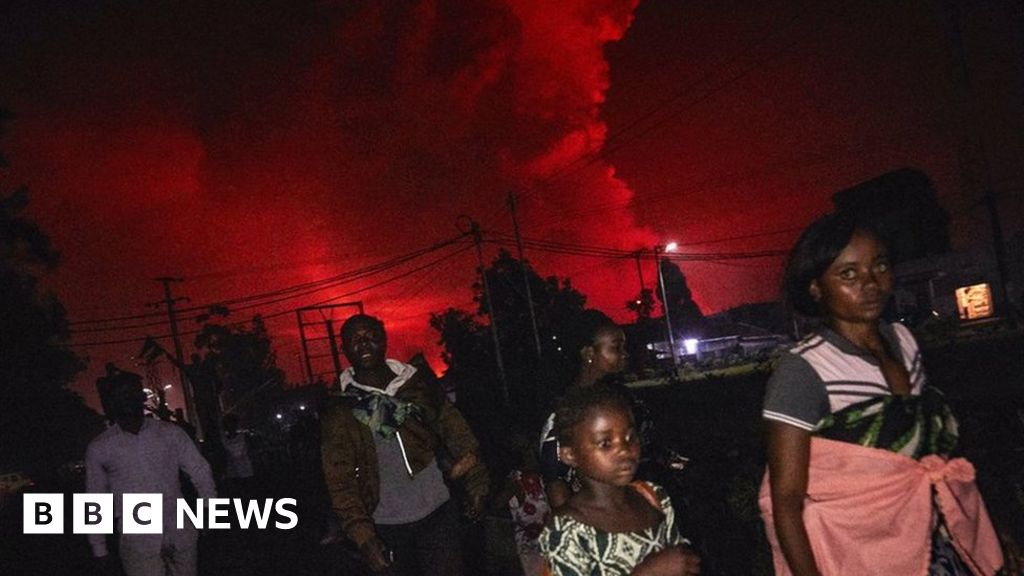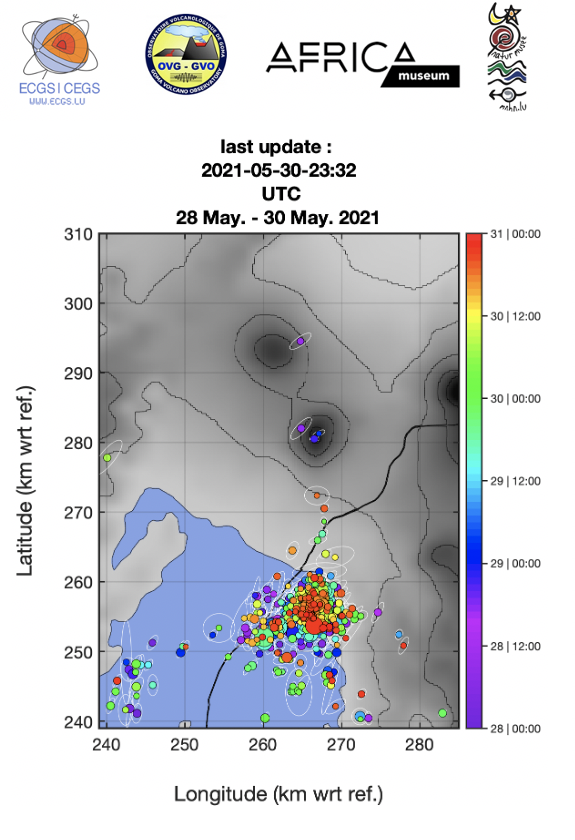I'm sorry to say that the crisis isn't over yet.
First, here's a map that VDAP (the USGS/USAID quick-response team) just
released of the surface lava eruption on May 22-23. They found three vents.
Okay: see the volcano (Shaheru is a flank cone; the lava lake that partly drained was up at Nyiragongo's summit), Goma and its surrounding urban area, and Lake Kivu (which contains enormous amounts of carbon dioxide and methane at depth and could explode)?
Well, per
this source:
Current seismicity and ground deformation data continue to indicate the presence of magma under the Goma urban area with extension under Lake Kivu. Seismicity remains high and continues to migrate southwards and surface deformation is still recorded by the GPS network and InSAR. These observations are consistent with the continued propagation of magma at depth towards the south. Because of the partial drainage of the lava lake associated to the continuous collapse of the crater inside the summit of Nyiragongo, ash fallout may again occur. Data on the stability of Lake Kivu currently show no significant change.
-- May 27th update
If this was almost anywhere else in the world, they would have all those millions out of harm's way.
But the Congo is really messed up. They only had their first peaceful transition of power in 2019; armed groups are fighting in the area, so earlier this month, the district that includes Goma was put under martial law; and corruption is allegedly so rampant that, according to
this tweet (Twitter translation), some of those who fled on the 22nd experienced "Extortion, intimidation, theft and confiscation of money: this is what some of the displaced persons who took the road to Minova suffered. If you have 100 dollars, we ask you for "a slip", otherwise we take 10 dollars. Computers and phones stolen by Police, military and ANR agents."
MONUSCO -- the UN peacekeepers -- are doing the best they can, but that isn't much. Don't know anything about the government, but I didn't see anyone in Congolese government taking a strong, effective leadership role during or after the eruption, when those millions of people really needed it.
This is such a rough place, maybe showing initiative like that, or even just doing your job, could get you and your family killed.
Things are better in Rwanda, I think, which is also at risk in this region. They, too, have an extremely painful history, but they seem more focused and actually have a tourism industry in this
UNESCO World Heritage area -- which could be great for the Congo, too, if it could get its act together. Rwandans are even mining methane VERY CAREFULLY from Lake Kivu for energy. But I've read that there's so much down there, it's not going to reduce the risk much and, again, must be done with extreme caution to avoid triggering a lake overturn (explosion).
Sorry to go on and on, but it really bothers me. Because of the urban development here, lake overturn could kill far more people than Krakatoa in 1883 and Tambora in 1815, combined, did -- in just five or ten minutes. And there is so little that can be done right now, though it's true that knowledgeable people in the Congo and around the world are working hard on it.
I read up on this while writing Nyiragongo up as a Decade Volcano. More research is needed, but experts suggest that the geologic record does show periodic overturns at Lake Kivu. However, magma flow under the land that's now occupied by Goma and the lake has been recognized before, without consequence as well as occasionally with eruption (Mount Goma, a hill in town -- near the lake, I think -- is the result of one of those eruptions; people took shelter there on May 22nd, and the volcano observatory sits there, too).
And too, after the 2002 eruption, which was even larger, there also was lots of seismicity, as there is now, although lack of instruments hindered expert understanding of what was going on down there.
This is just something that Nyiragongo does, often without terrible consequences of biblical proportion for people living nearby.
Let's hope that this is one of those times with a relatively good outcome.
Edit: Forgot to mention an excellent information source: the Smithsonian's Global Volcanism Program's
Nyiragongo page. The latest report, up to the 25th, is sobering.
Also, going back on Twitter, found this video of one of Goma's districts -- makes it more than just a foreign place name. And there is the lake, right there.



